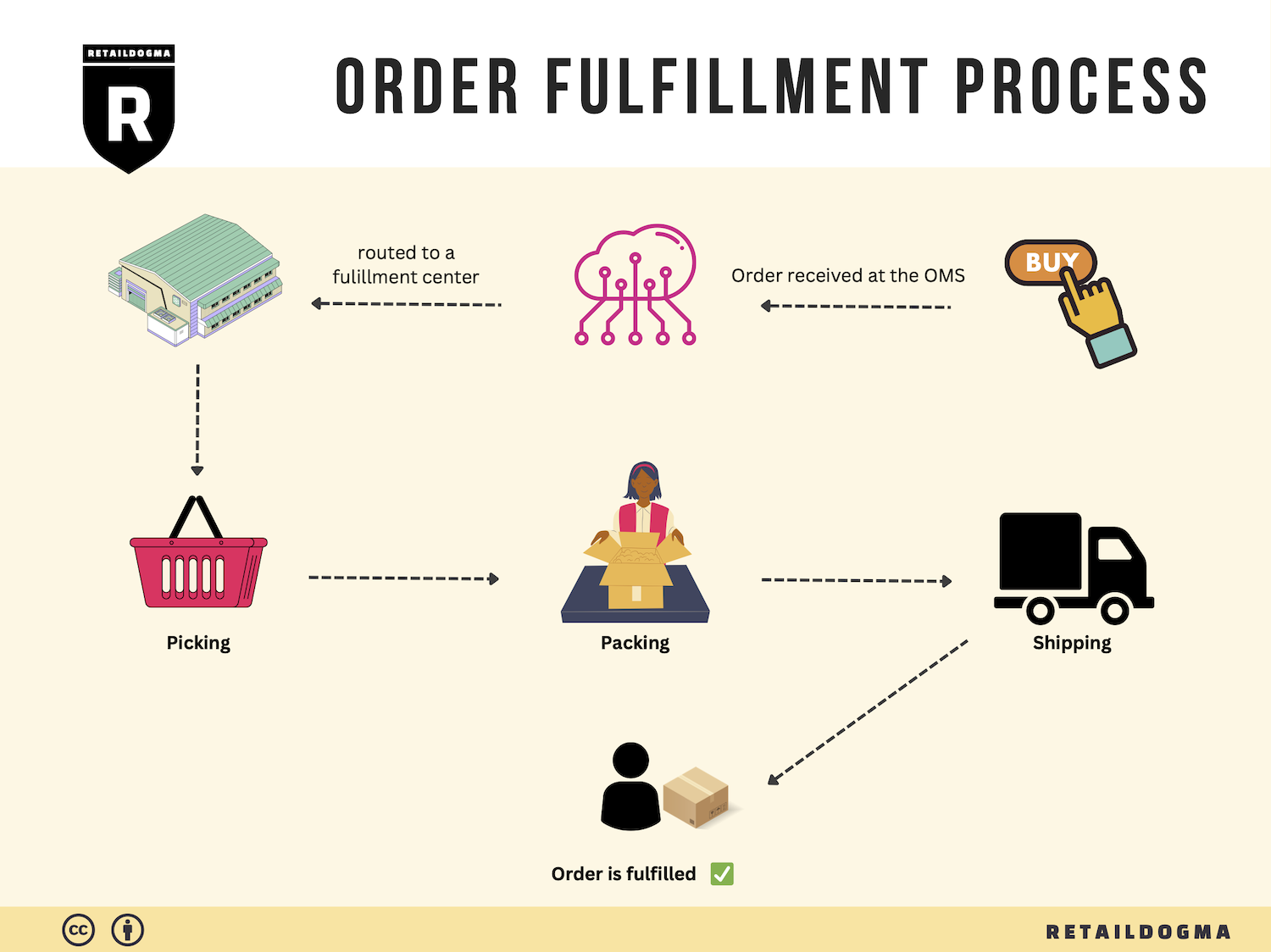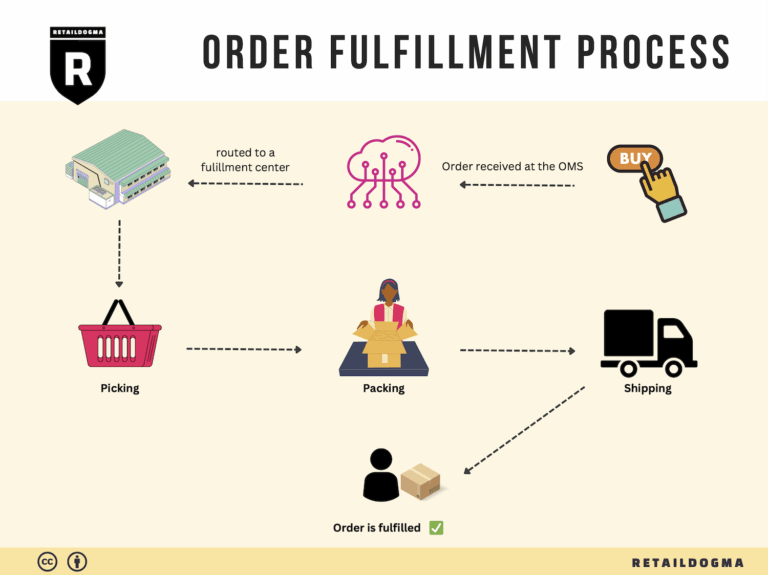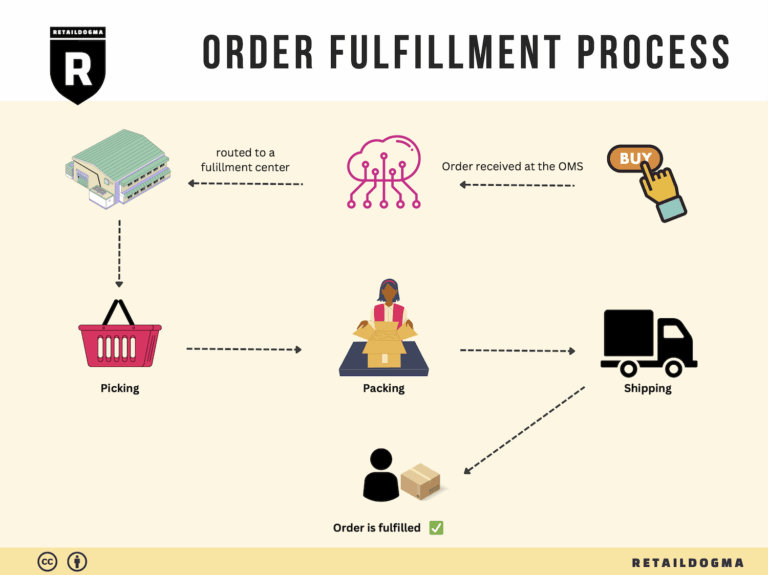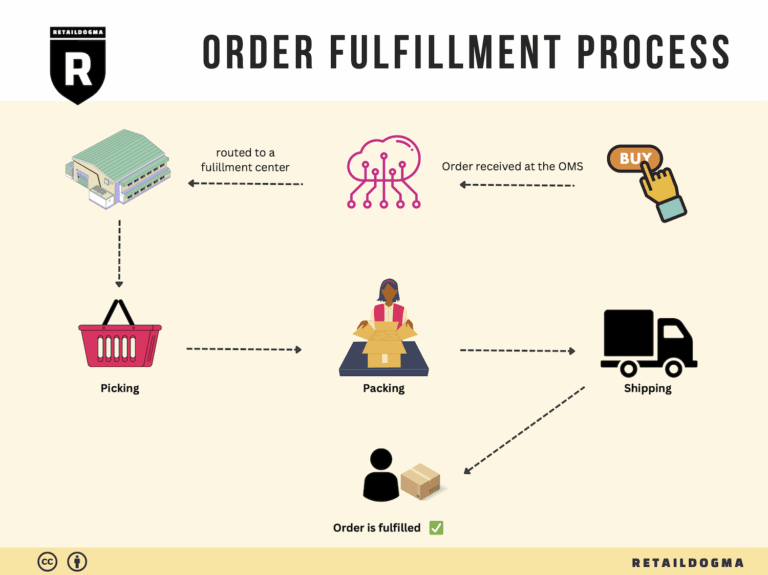How Order Fulfillment Works: A Step-by-Step Guide for Businesses
What is E-commerce Fulfillment? An Introduction for Growing Businesses
Understanding E-commerce Fulfillment: A Key to Scaling Your Business
As an e-commerce business owner, you may find yourself grappling with one of the most daunting aspects of growth: the logistics of packing and shipping orders. The excitement of increasing sales can quickly turn into an overwhelming burden when faced with the complexities of order fulfillment. You may have experienced late shipments, inventory mismanagement, or simply the struggle of managing time between order processing and other critical business functions.
At its core, e-commerce fulfillment is the process of getting a product from your inventory to your customer’s doorstep. It encompasses everything from receiving inventory and storing products to picking, packing, and shipping orders, along with handling returns and customer service. As your business expands, understanding and optimizing this process becomes vital to your success.
This guide aims to demystify e-commerce fulfillment for growing businesses by providing actionable insights into various fulfillment models, such as Third-Party Logistics (3PL) and Fulfillment by Amazon (FBA). We will explore the core services offered by fulfillment centers, including warehousing, inventory management, order processing, and shipping. Understanding these services will help you assess which fulfillment strategy aligns best with your business needs.
Choosing the right fulfillment partner can be a game-changer for your operations. This guide will delve into the criteria for selecting a fulfillment provider, emphasizing factors like reliability, scalability, technology integration, and customer support. Additionally, we will discuss pricing structures associated with different fulfillment models, helping you to budget effectively as you scale.
Ultimately, the goal of this guide is to empower you to make informed decisions about your logistics. By understanding the nuances of e-commerce fulfillment, you can streamline your operations, enhance customer satisfaction, and focus on growing your business rather than getting bogged down by logistics challenges. With the right knowledge and tools at your disposal, you can transform fulfillment from a pain point into a competitive advantage.
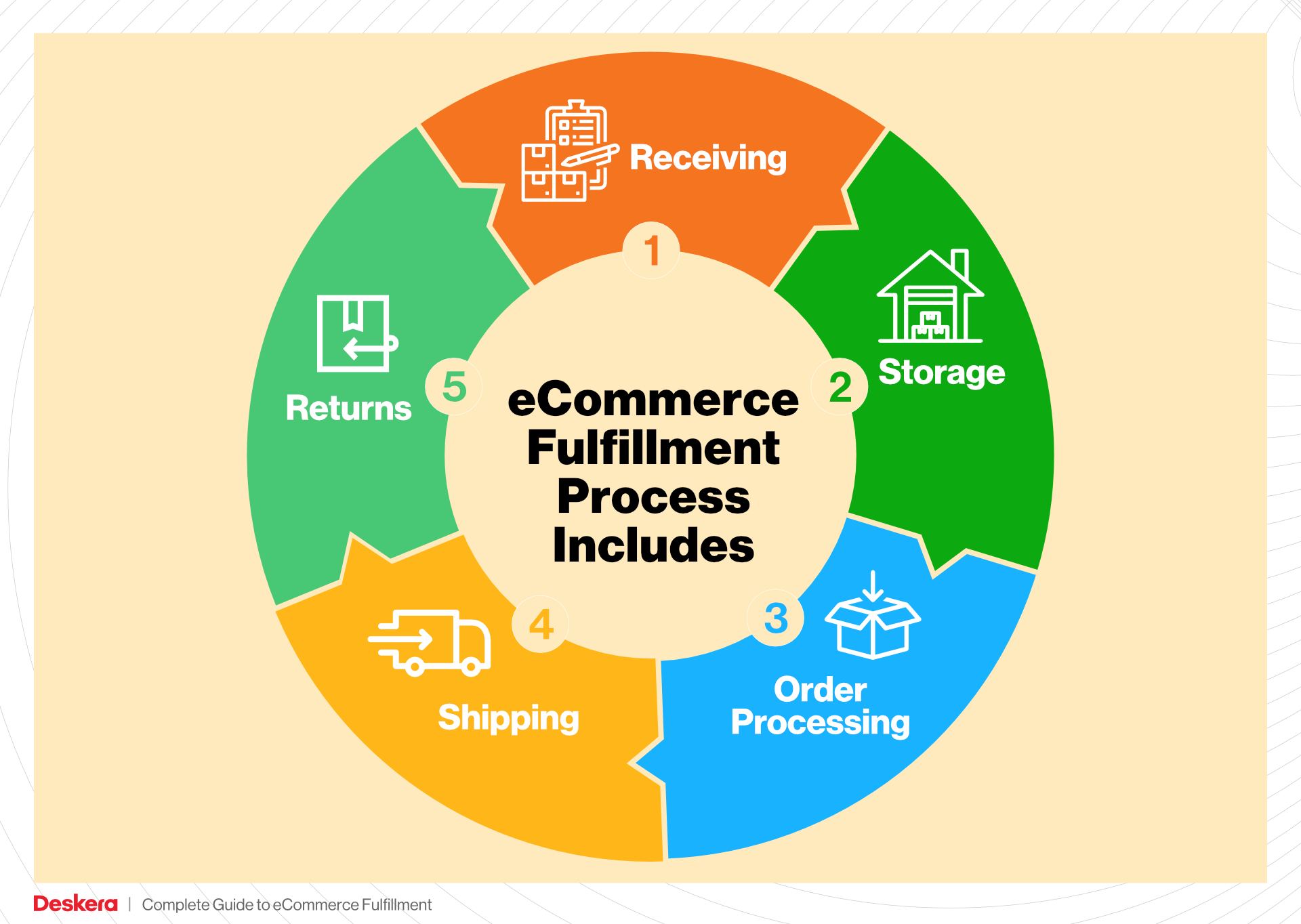
What You’ll Learn In This Guide
- What is E-commerce Fulfillment? An Introduction for Growing Businesses
- The Order Fulfillment Process: From ‘Buy’ Button to Customer’s Door
- Comparing Fulfillment Models: In-House vs. 3PL vs. Dropshipping
- A Deep Dive into Amazon FBA: Pros, Cons, and Who It’s For
- Core Services Offered by Fulfillment Centers
- How to Choose a Fulfillment Partner: A 6-Point Checklist
- Understanding Fulfillment Pricing: A Breakdown of Common Fees
- Frequently Asked Questions (FAQs) about Fulfillment
- Conclusion: Is Outsourcing Fulfillment the Right Move for Your Business?
- Important Disclaimer
The Order Fulfillment Process: From ‘Buy’ Button to Customer’s Door
1. Receiving Inventory
The first step in the order fulfillment process is receiving inventory, which involves the acceptance of goods from suppliers into the warehouse. This step is crucial as it sets the foundation for all subsequent activities. Upon arrival, products are checked against purchase orders to ensure accuracy in quantity and quality.
Key terminology associated with this step is SKU (Stock Keeping Unit). An SKU is a unique identifier assigned to each product, enabling efficient tracking throughout the fulfillment process. Properly managing SKUs during receiving helps minimize discrepancies and ensures that the right items are available for order fulfillment.
Effective inventory management at this stage can prevent stockouts and overstock situations, which are detrimental to cash flow and customer satisfaction. Implementing robust receiving protocols, such as automated scanning and verification systems, can streamline this process, enhancing accuracy and efficiency.
2. Warehouse Storage
Once inventory is received, the next step is warehouse storage. This involves placing products in designated storage locations within the fulfillment center. The organization of storage is critical for optimizing space and facilitating quick retrieval of items when orders are placed.
A common practice in this stage is the use of slotting, which refers to the strategic placement of products based on their demand patterns. High-demand items are often stored closer to the packing area to reduce retrieval time. Efficient warehouse storage not only maximizes the use of space but also minimizes labor costs associated with picking.
Properly organized storage systems enhance visibility of inventory, allowing for real-time stock tracking and management. This is essential for maintaining adequate stock levels and ensuring that popular items are readily available, ultimately leading to improved customer satisfaction.
3. Order Picking
Order picking is the process of retrieving items from storage to fulfill customer orders. This step is vital as it directly impacts the speed and accuracy of order fulfillment. Efficient picking processes are crucial for meeting customer expectations, especially in a competitive e-commerce environment.
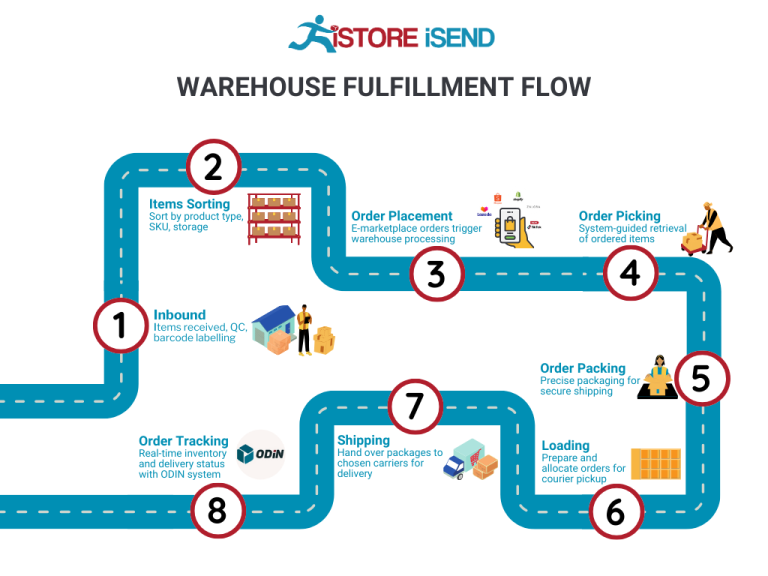
A key tool in this phase is the pick list, which is a document or digital notification that outlines the items and quantities required for each order. Utilizing technology such as barcode scanners or mobile devices can significantly enhance picking accuracy and efficiency.
Various picking methods, such as single-order picking or batch picking, can be employed depending on the volume of orders and types of products. Streamlining this process can lead to faster turnaround times and reduced labor costs, ultimately enhancing the overall customer experience.
4. Order Packing
After items are picked, the next step is order packing, which involves securely packaging the products for shipment. This step is critical in ensuring that items arrive at the customer’s door in perfect condition. Proper packing not only protects the products but also enhances the unboxing experience for customers.
Key considerations in this phase include the use of packaging materials that provide adequate protection without incurring excessive costs. Businesses should also ensure that packing processes are efficient, potentially utilizing automated packing systems where feasible.
Effective packing strategies can lead to reduced shipping costs and lower return rates, as well-packaged items are less likely to be damaged in transit. Additionally, incorporating branding elements into packaging can enhance customer perception and loyalty.
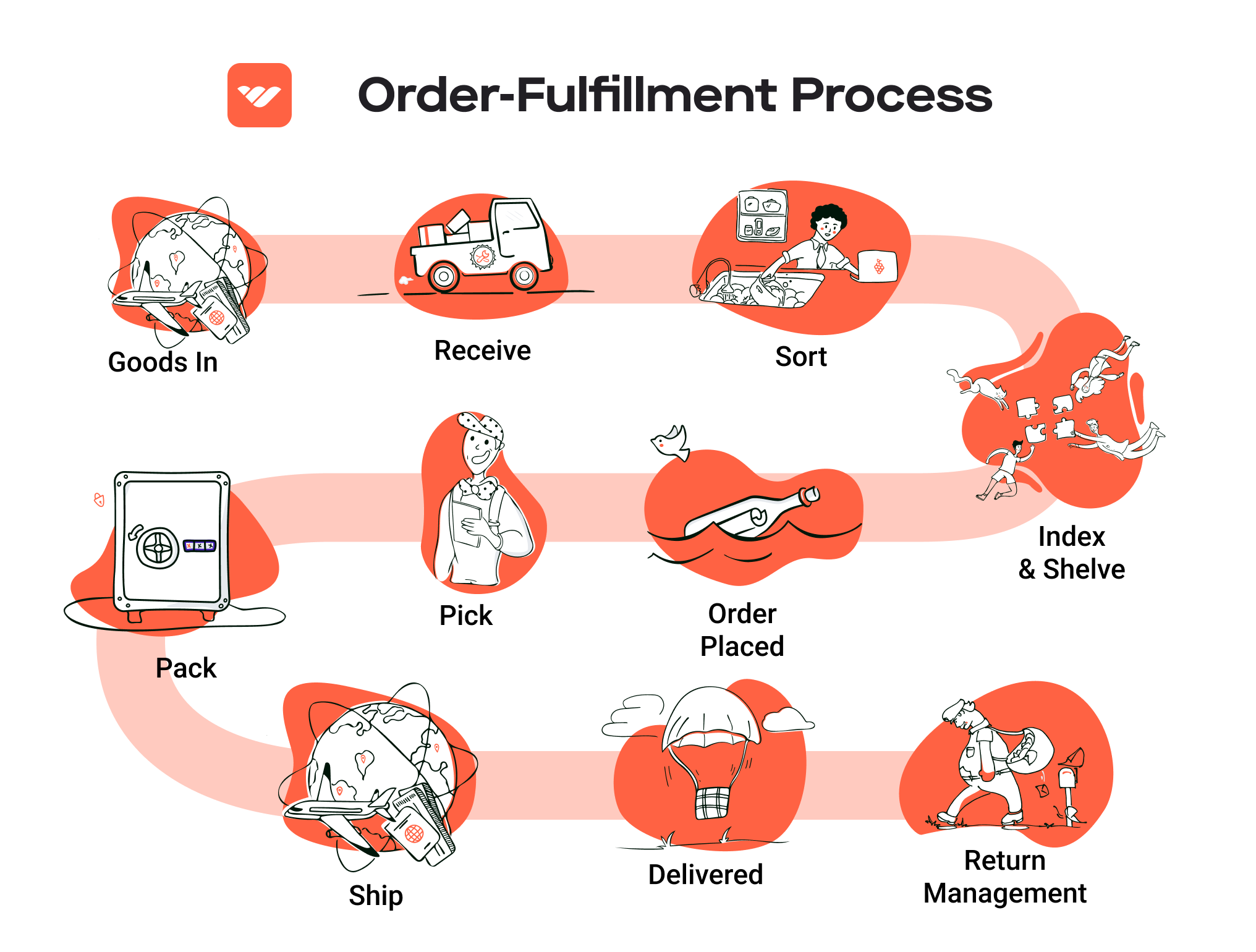
5. Shipping & Delivery
The final step in the order fulfillment process is shipping and delivery, which involves transporting the packaged order to the customer’s location. This step is crucial as it represents the culmination of the entire fulfillment process, directly impacting customer satisfaction and retention.
A key term associated with this stage is last-mile delivery, which refers to the final leg of the shipping journey from a distribution center to the end customer. Efficient last-mile delivery is essential for meeting delivery promises and can be a significant factor in customer satisfaction.
To optimize shipping and delivery, businesses should evaluate various carrier options and delivery methods, considering factors such as speed, cost, and reliability. Implementing real-time tracking systems can also enhance transparency for customers, allowing them to monitor the status of their orders.
In conclusion, understanding and optimizing each step of the order fulfillment process is essential for e-commerce businesses looking to scale their operations. By focusing on efficiency and accuracy at each stage—from receiving inventory to shipping and delivery—business owners can enhance customer satisfaction and drive growth.
Comparing Fulfillment Models: In-House vs. 3PL vs. Dropshipping
Fulfillment Model Comparison
| Model | Who Handles Inventory | Best For (Business Stage) | Key Advantage | Key Disadvantage |
|---|---|---|---|---|
| In-House Fulfillment | The business itself | Established businesses with steady demand | Full control over inventory and processes | High overhead costs and complexity |
| Third-Party Logistics (3PL) | An external logistics provider | Growing businesses scaling operations | Cost-effectiveness and scalability | Less control over inventory and processes |
| Dropshipping | Suppliers or manufacturers | Startups and small businesses | Low startup costs and low risk | Lower profit margins and reliance on suppliers |
In-House Fulfillment
In-house fulfillment involves managing the entire inventory process internally. This model is typically adopted by established businesses that have reached a level of steady demand that justifies the investment in warehousing, staff, and technology. The key advantage of in-house fulfillment is the level of control it affords over inventory management, order processing, and customer service. Businesses can tailor their operations to meet specific customer needs and can quickly respond to changes in demand or preferences. However, this control comes at a cost. The overhead associated with maintaining a warehouse, hiring staff, and managing logistics can be substantial. Furthermore, as order volume grows, the complexity of operations can increase, requiring sophisticated systems and processes that may not be feasible for all businesses.
Third-Party Logistics (3PL)
Third-party logistics (3PL) providers manage the storage, handling, and shipping of products on behalf of a business. This model is ideal for growing businesses that need to scale their operations without the burden of managing logistics internally. By outsourcing fulfillment to a 3PL, companies can benefit from reduced operational costs and increased efficiency. Many 3PLs offer advanced technology solutions, including inventory management systems and shipping software, which can streamline operations. However, the trade-off is a loss of direct control over inventory and fulfillment processes. Businesses must rely on their 3PL partner to maintain quality standards and meet delivery expectations. Establishing a strong relationship with a 3PL is crucial, as poor performance can negatively impact customer satisfaction.
Dropshipping
Dropshipping is a fulfillment model where businesses sell products without holding any inventory. Instead, when a customer places an order, the business purchases the item from a third-party supplier who then ships it directly to the customer. This model is particularly appealing to startups and small businesses due to its low startup costs and minimal risk. Entrepreneurs can focus on marketing and sales rather than inventory management and logistics. However, dropshipping comes with its own set of challenges. The most significant is the lower profit margins, as businesses often pay wholesale prices that limit their ability to mark up products. Additionally, reliance on suppliers can lead to issues with stock availability and shipping times, which may harm customer satisfaction. For businesses considering dropshipping, it’s essential to vet suppliers carefully and maintain clear communication to mitigate potential issues.
A Deep Dive into Amazon FBA: Pros, Cons, and Who It’s For
Understanding Fulfillment by Amazon (FBA)
Fulfillment by Amazon (FBA) is a service offered by Amazon that allows sellers to store their products in Amazon’s fulfillment centers. Amazon takes care of storage, packaging, and shipping, as well as handling customer service and returns on behalf of the sellers. This service is designed to simplify the logistics process for e-commerce businesses, enabling them to scale operations without the complexity of managing their own warehouses or shipping processes.
When a customer places an order for a product listed by a seller using FBA, Amazon handles the entire process. This includes picking the item from the warehouse, packing it, and shipping it directly to the customer. Sellers can also benefit from Amazon’s customer service capabilities, which further enhances the shopping experience for customers.
How FBA Works
- Account Setup: Sellers create an Amazon Seller Central account and opt for the FBA service.
- Inventory Preparation: Products need to be prepared and packaged according to Amazon’s guidelines. This may include labeling, bundling, and ensuring the product is compliant with Amazon’s policies.
- Shipping to Amazon: Sellers ship their products to Amazon’s fulfillment centers. They can choose which center to send their inventory to based on Amazon’s recommendations.
- Storage: Amazon stores the products in their warehouses until they are sold.
- Order Fulfillment: When a customer purchases a product, Amazon picks, packs, and ships the product directly to the customer. The seller is notified of the sale.
- Customer Service and Returns: Amazon manages customer inquiries and returns, providing a seamless experience for both sellers and buyers.
Pros of Using Amazon FBA
-
Prime Eligibility: Products fulfilled by Amazon are automatically eligible for Amazon Prime, which increases visibility and attractiveness to millions of Prime members who prefer quick, free shipping.
-
Customer Trust: Leveraging Amazon’s established brand and reputation instills confidence in customers. Buyers are more likely to purchase from sellers who use FBA due to Amazon’s reliable customer service and return policies.
-
Multi-Channel Fulfillment: FBA allows sellers to fulfill orders from other sales channels (like eBay or their own websites) using Amazon’s logistics network, simplifying inventory management and shipping processes.
-
Scalability: FBA enables businesses to scale quickly. As sales increase, sellers can rely on Amazon’s infrastructure to handle the logistics without needing to invest heavily in their own warehousing and shipping solutions.
-
Time Savings: By outsourcing logistics to Amazon, sellers can focus more on growing their business, marketing, and product development rather than worrying about the logistics of order fulfillment.
Cons of Using Amazon FBA
-
High Fees: FBA comes with various fees, including storage fees for holding products in Amazon’s warehouses and fulfillment fees for picking, packing, and shipping items. These costs can eat into profit margins, particularly for low-cost items.
-
Strict Inventory Rules: Amazon has strict policies regarding inventory management, including restrictions on how much inventory can be stored. Sellers must be diligent in monitoring their stock levels to avoid incurring additional fees or penalties.
-
Commingling Risks: FBA may involve commingling inventory from different sellers. This means that a seller’s products may be mixed with those of other sellers, which could lead to issues if a customer receives a defective product from another seller’s inventory.
-
Less Control Over Shipping: When using FBA, sellers relinquish control over the shipping process, which can lead to inconsistencies in delivery times and customer service experiences. Issues such as delays or lost items must be resolved through Amazon’s customer service channels.
-
Potential for Inventory Loss: There’s always a risk of inventory being lost or damaged while in Amazon’s warehouses, and resolving these issues can be cumbersome.
Who is FBA Best For?
Fulfillment by Amazon is particularly beneficial for:
-
Small to Medium-Sized Businesses: Businesses that lack the resources to manage their own logistics can leverage FBA to access Amazon’s vast infrastructure without the need for significant upfront investment.
-
E-commerce Entrepreneurs: New entrepreneurs looking to enter the e-commerce space can benefit from Amazon’s established customer base and streamlined processes, allowing them to focus on marketing and sales.
-
Brands Seeking to Scale: Companies aiming to expand their reach and sales volume can utilize FBA to handle increased order volumes efficiently without the need for additional staffing or warehousing.
-
Sellers with Diverse Product Lines: Businesses offering a wide variety of products can benefit from Amazon’s multi-channel fulfillment capabilities, allowing them to manage inventory across different platforms while maintaining a consistent shipping experience.
In conclusion, while FBA presents an opportunity for e-commerce sellers to leverage Amazon’s extensive logistics network and customer trust, it’s essential to weigh the associated costs and potential downsides. For many businesses, particularly those looking to scale quickly and efficiently, FBA can be a powerful tool in their e-commerce strategy.
Core Services Offered by Fulfillment Centers
Inventory Management & Warehousing
Inventory management and warehousing are foundational services provided by fulfillment centers. This involves the systematic tracking and storage of products within a facility, ensuring that businesses maintain optimal stock levels and can efficiently fulfill customer orders.
The key benefits of effective inventory management include:
-
Reduced Holding Costs: By utilizing a fulfillment center, e-commerce businesses can minimize the costs associated with maintaining their own warehouses. Fulfillment centers typically operate at larger scales, allowing for economies of scale that reduce overall storage costs.
-
Real-Time Inventory Tracking: Advanced inventory management systems employed by fulfillment centers provide businesses with real-time data on stock levels. This transparency allows for better decision-making regarding restocking and order fulfillment, ultimately reducing the risk of stockouts or overstock situations.
-
Enhanced Organization: Fulfillment centers implement sophisticated warehousing strategies, such as FIFO (First In, First Out) or LIFO (Last In, First Out), which help maintain product integrity and ensure timely order processing. This organized approach enables faster picking and shipping times, improving customer satisfaction.
Pick and Pack Services
Pick and pack services are crucial components of the order fulfillment process. This service involves selecting the correct items from the inventory and packaging them for shipment.
The advantages of utilizing pick and pack services include:
-
Increased Efficiency: Fulfillment centers specialize in high-volume order processing, employing trained staff and optimized systems to ensure that orders are picked and packed quickly. This efficiency can significantly reduce the time from order placement to delivery, enhancing the overall customer experience.
-
Accuracy in Fulfillment: With dedicated staff and technology designed to minimize human error, fulfillment centers provide a high level of accuracy in order fulfillment. This reduces the likelihood of returns due to incorrect items being shipped, thus saving businesses on return processing costs and improving customer satisfaction.
-
Customization Options: Many fulfillment centers offer customizable packaging options, allowing e-commerce businesses to enhance their branding. This can include branded boxes, packing slips, and promotional materials, which can help build customer loyalty and recognition.
Kitting and Assembly
Kitting and assembly services involve the process of combining multiple products or components into a single package or kit. This is especially beneficial for businesses that sell products that are often bundled together or require assembly before shipping.
The benefits of kitting and assembly services include:
-
Streamlined Operations: By outsourcing kitting and assembly to a fulfillment center, businesses can free up internal resources and focus on core operations such as marketing and customer service. This allows for greater scalability and flexibility in meeting customer demands.
-
Improved Product Presentation: Kitting allows businesses to present products in a more attractive and organized manner, potentially increasing perceived value. Well-packaged kits can enhance customer satisfaction and lead to higher sales conversions.
-
Cost Savings: Fulfillment centers often have the expertise and tools to efficiently assemble kits at a lower cost than businesses could achieve independently. This can lead to reduced labor costs and increased profitability.
Returns Management (Reverse Logistics)
Returns management, or reverse logistics, is the process of handling returned products. This service is crucial for e-commerce businesses, as effective returns management can directly impact customer satisfaction and loyalty.
The benefits of robust returns management services include:
-
Streamlined Return Processes: Fulfillment centers can provide a standardized return process that simplifies the experience for customers. This includes providing return labels, tracking returns, and processing refunds or exchanges swiftly.
-
Data Insights: By analyzing return data, fulfillment centers can provide valuable insights into customer behavior and product performance. Understanding why items are returned can help businesses improve product quality and customer satisfaction, ultimately reducing future return rates.
-
Cost Efficiency: Handling returns in-house can be resource-intensive and costly. By outsourcing returns management to a fulfillment center, businesses can reduce overhead costs and improve operational efficiency. Fulfillment centers often have established processes that expedite returns and minimize losses associated with returned inventory.
In conclusion, leveraging the core services offered by fulfillment centers can significantly enhance the operational efficiency and customer satisfaction of e-commerce businesses. From inventory management to returns management, these services not only streamline logistics but also allow businesses to focus on growth and customer engagement. By selecting the right fulfillment partner, e-commerce owners can position themselves for scalability and success in an increasingly competitive market.
How to Choose a Fulfillment Partner: A 6-Point Checklist
Location & Warehouse Network
The geographical location of your fulfillment partner’s warehouses can significantly impact shipping times and costs. A partner with strategically placed facilities can help ensure faster delivery to your customer base.
Why It’s Important:
– Shipping Costs: Proximity to your target market reduces shipping expenses.
– Delivery Speed: Shorter distances lead to quicker delivery times, enhancing customer satisfaction.
Questions to Ask:
– Where are your warehouses located, and how many do you operate?
– Can you accommodate my distribution needs based on my target market?
– Do you have a plan for expanding your network as my business grows?
Technology & Integrations
A robust technological infrastructure is essential for efficient operations and seamless communication. Your fulfillment partner should offer integrations with your e-commerce platform and provide real-time inventory tracking.
Why It’s Important:
– Automation: Technology can streamline order processing and inventory management.
– Data Access: Real-time analytics help you make informed decisions regarding stock levels and sales trends.
Questions to Ask:
– What systems do you use for inventory management and order processing?
– Can your platform integrate with my existing e-commerce systems (e.g., Shopify, WooCommerce)?
– What kind of reporting and analytics do you provide?
Specializations (e.g., Cold Storage, Oversized Items)
Depending on your product offerings, you may need a fulfillment partner with specific capabilities, such as cold storage for perishables or handling oversized items.
Why It’s Important:
– Product Suitability: A partner specialized in your product category will ensure proper handling and storage.
– Compliance: Certain products may require adherence to regulations that specialized partners are equipped to manage.
Questions to Ask:
– What specializations do you offer that align with my product needs?
– How do you ensure compliance with regulations relevant to my products?
– Can you provide examples of clients with similar product needs?
Scalability & Capacity
As your business grows, your fulfillment partner should be able to scale operations accordingly. This includes both physical capacity and operational flexibility.
Why It’s Important:
– Growth Support: A partner that can grow with you can prevent disruptions in service as order volumes increase.
– Adaptability: Changes in market demand require a partner that can quickly adjust its operations.
Questions to Ask:
– How do you handle peak seasons or unexpected spikes in order volume?
– Can you scale your services to accommodate future growth?
– What infrastructure do you have in place to support increased capacity?
Pricing and Contracts
Understanding the pricing structure and contract terms is critical to maintaining profitability. Hidden fees or unfavorable terms can erode margins.
Why It’s Important:
– Cost Transparency: Clear pricing structures help you accurately forecast fulfillment costs.
– Long-term Viability: Favorable contract terms can protect your business interests over time.
Questions to Ask:
– What are your pricing models (e.g., per order, per item, monthly fees)?
– Are there any additional fees I should be aware of (e.g., storage, handling, returns)?
– What are the terms for contract termination or renewal?
Customer Support & Reviews
Reliable customer support can make or break your relationship with a fulfillment partner. Additionally, looking at reviews and testimonials can provide insight into their reliability and service quality.
Why It’s Important:
– Responsiveness: Quick, effective support can resolve issues before they escalate.
– Reputation: Positive reviews indicate a history of satisfied clients and consistent service delivery.
Questions to Ask:
– What customer support channels do you offer (e.g., phone, email, chat)?
– What are your average response times for customer inquiries?
– Can you provide references or case studies from current clients?
By following this checklist, e-commerce business owners can make informed decisions when selecting a fulfillment partner. Each of these elements plays a crucial role in ensuring that your logistics operations are efficient, cost-effective, and capable of meeting customer expectations.
Understanding Fulfillment Pricing: A Breakdown of Common Fees
Initial Setup Fees
Initial setup fees are often the first costs that e-commerce businesses encounter when partnering with a fulfillment center. These fees are charged for establishing your account, integrating your systems, and configuring your product listings within the fulfillment provider’s platform.
The calculation of initial setup fees varies widely among providers, but they typically range from a few hundred to several thousand dollars, depending on the complexity of your operation. Factors influencing the cost include the number of products to be set up, the level of integration required with your e-commerce platform, and any additional services like customized packaging.
To manage these costs effectively, businesses should seek out fulfillment centers that offer transparent pricing structures and clearly outline what is included in the setup fee. Ask for a detailed breakdown of the services provided to ensure you are not overpaying for unnecessary features.
Receiving Fees
Receiving fees are incurred when the fulfillment center accepts your inventory. This fee covers the labor involved in unloading, inspecting, and storing your products.
Typically, receiving fees are calculated based on the volume of inventory being received, often measured in units or pallets. For example, a fulfillment center may charge $0.50 per item or $25 per pallet. It’s crucial to understand that additional charges may apply if your inventory requires special handling or if it arrives in a particularly disorganized state.
To optimize costs, ensure that your inventory is well-prepared for receiving. This includes clear labeling, proper packaging, and providing advance notice to the fulfillment center about incoming shipments.
Storage Fees (per pallet/bin)
Storage fees are charged for the space your inventory occupies in the fulfillment center. These fees can be calculated on a monthly basis and are typically based on the volume of space used, either by pallet or bin.
For instance, a common pricing model might charge $20 to $30 per pallet per month or around $5 to $10 per bin. Some fulfillment centers may also implement tiered pricing, where the cost per pallet decreases as the number of pallets stored increases.
To minimize storage fees, businesses should maintain an efficient inventory turnover rate. This means closely monitoring stock levels and ensuring that slow-moving items are either discounted or removed from the inventory to free up space.
Pick & Pack Fees (per item/order)
Pick and pack fees are charged for the labor involved in retrieving items from storage, packing them for shipment, and preparing them for delivery. This fee is typically calculated on a per-order or per-item basis.
For example, fulfillment centers might charge $1.00 per item picked and $1.50 per order packed. The complexity of the order can also influence these fees; for instance, orders that require special packaging materials may incur additional charges.
To reduce pick and pack fees, consider optimizing your product catalog by reducing the number of variations or combining similar items into bundles. Streamlining order fulfillment processes can also lead to efficiency gains, potentially lowering the overall costs.
Shipping Fees
Shipping fees encompass the costs associated with transporting your products to customers. These fees can vary based on factors such as destination, package weight, dimensions, and the shipping method chosen (e.g., standard, expedited, or same-day delivery).
Fulfillment centers typically have partnerships with various carriers, allowing them to negotiate shipping rates. Businesses may find that shipping fees are calculated based on a flat rate per package, a tiered pricing model based on weight, or even a combination of both.
To get the best rates, it’s advisable to compare shipping options and consider using fulfillment centers that offer discounted shipping rates due to their volume agreements with carriers. Additionally, utilizing regional distribution centers can help reduce shipping distances and, consequently, costs.
Tips for Getting an Accurate Quote
-
Provide Detailed Information: When requesting a quote, supply comprehensive details about your inventory, including dimensions, weights, and expected order volumes. The more information you provide, the more accurate the quote will be.
-
Ask for a Breakdown: Request a detailed breakdown of all fees, including any potential hidden costs. Understanding how each fee is calculated will help you avoid surprises later.
-
Negotiate Terms: Don’t hesitate to negotiate terms and pricing based on your expected volume or long-term commitment to the fulfillment center. Many providers are willing to offer discounts for high-volume clients.
-
Evaluate Additional Services: Consider what additional services you may need, such as returns processing or custom packaging. Make sure these are factored into your overall pricing.
-
Request Sample Calculations: Ask for sample calculations based on your expected order scenarios. This will give you a clearer picture of what your fulfillment costs might look like as your business scales.
By understanding these common fulfillment pricing models and employing strategic measures to optimize costs, e-commerce businesses can significantly enhance their operational efficiency and profitability.
Frequently Asked Questions (FAQs) about Fulfillment
1. What is the ABE4 Amazon Fulfillment Center?
The ABE4 Amazon Fulfillment Center is a large logistics facility located in Easton, Pennsylvania. It is part of Amazon’s extensive network designed to efficiently store, pick, pack, and ship a wide variety of products, helping to ensure quick delivery to customers in the region.
2. What types of products are fulfilled at ABE4?
ABE4 handles a diverse range of products, including clothing, household essentials, electronics, and more. The center is specifically designed to manage the fulfillment of small to medium-sized items, ensuring that customer orders are processed and dispatched swiftly.
3. How does ABE4 differ from a traditional warehouse?
While both fulfillment centers and traditional warehouses are used for storage, fulfillment centers focus on the entire process of order fulfillment. This includes receiving inventory, picking items from shelves, packing them for shipment, and managing returns. In contrast, traditional warehouses primarily serve as storage spaces without the additional operational functions related to order processing.
4. What is a third-party logistics provider (3PL)?
A third-party logistics provider (3PL) is a service that allows businesses to outsource their logistics and fulfillment operations. 3PLs manage various aspects of the supply chain, including warehousing, inventory management, and transportation, enabling businesses to focus on their core competencies while improving efficiency and reducing costs.
5. How much do fulfillment services cost at ABE4?
Fulfillment service costs can vary based on several factors, including the volume of orders, the types of products being stored and shipped, and the specific services required (e.g., packaging, returns management). Typically, costs are calculated based on storage fees, order processing fees, and shipping costs. Businesses should contact Amazon directly for a detailed quote tailored to their specific needs.
6. What are the operational hours of ABE4?
The ABE4 Amazon Fulfillment Center operates 24 hours a day, seven days a week, to accommodate the high volume of orders and ensure timely processing. However, specific operational hours may vary depending on the department and seasonality.
7. How can I track my orders fulfilled by ABE4?
Customers can track their orders through their Amazon account. Once an order is placed, a tracking number will be provided, allowing customers to monitor the shipment’s progress in real-time. Additionally, updates are sent via email regarding shipping status and estimated delivery dates.
8. What measures does ABE4 take to ensure product safety and quality?
ABE4 adheres to strict safety and quality standards, including regular inventory checks, proper storage conditions, and thorough training for employees on handling products safely. Additionally, quality control processes are in place to identify and address any issues before products are shipped to customers.
9. Can I return items fulfilled by ABE4?
Yes, items fulfilled by ABE4 can be returned according to Amazon’s return policy. Generally, most new and unopened items can be returned within 30 days of delivery for a full refund. Customers should refer to the specific return instructions provided with their order or visit Amazon’s return policy page for more details.
10. How does ABE4 manage peak season demands?
During peak seasons, such as holidays, ABE4 increases staffing levels and optimizes its operational processes to handle the surge in order volume. This includes hiring seasonal workers, implementing advanced technology for inventory management, and enhancing logistics strategies to ensure timely fulfillment and delivery.
Conclusion: Is Outsourcing Fulfillment the Right Move for Your Business?
Evaluating the Benefits of Outsourcing Fulfillment
Outsourcing fulfillment can be a transformative decision for e-commerce businesses looking to scale efficiently. By leveraging a fulfillment service, companies can significantly reduce operational burdens, allowing them to focus on core business activities. One of the most compelling benefits is time savings; with a fulfillment partner managing inventory, shipping, and returns, business owners can redirect their efforts towards strategic growth initiatives such as marketing and product development.
Scalability is another critical advantage. As demand fluctuates, especially during peak seasons, fulfillment partners can adjust resources to meet changing needs without the hassles of hiring and training new staff. This flexibility ensures that your business can grow without the constraints of a rigid logistics framework.
Moreover, specialized fulfillment services bring expertise to the table. Companies like Amazon’s ABE4 Fulfillment Center have years of experience in logistics and customer service, which can enhance your operational efficiency. They are equipped with advanced technologies and best practices that can help streamline your processes and improve customer satisfaction.
However, the choice of a fulfillment partner is crucial. Not all providers are created equal; aligning with a partner that understands your business model and customer expectations is vital for long-term success. Conducting due diligence—evaluating their track record, technology, and customer service—is essential.
Take Action Today
To determine if outsourcing fulfillment is the right next step for your business, start by auditing your current shipping and logistics processes. Analyze your pain points, identify inefficiencies, and consider how a fulfillment partner could alleviate these challenges. Engaging with a reliable fulfillment service could not only enhance your operational capabilities but also position your business for sustainable growth in an increasingly competitive market.
Important Disclaimer
⚠️ Important Disclaimer
The information in this guide is for educational purposes. Fulfillment services, pricing, and platform features change frequently. Always conduct your own due diligence and consult with providers directly before making business decisions.
